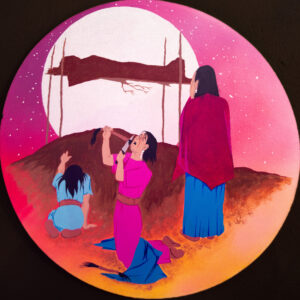
In past columns, I have mentioned the St. Stephens Indian Mission in St. Stephens, Wyoming. The mission is a diocesan parish on the Wind River Indian Reservation. St. Stephens has been the Catholic presence on the reservation since the Jesuits arrived in 1884 and established the mission.
There are three Catholic churches on the reservation; St. Stephens is the primary church. Inside, the church is replete with Arapaho culture intertwined with Catholic symbols and structures. Beautiful is a word that falls far short in describing the church. It is not beautiful like the cathedrals in Europe; it is beautiful in the deep spirituality of a people who have completely embraced Catholicism without abandoning their unique culture.
One of the most striking cultural blendings is in the Stations of the Cross that adorn the walls on both sides of the church. The paintings were created by a local Arapaho artist and, like much of the artwork, combine both Indian and Anglo cultures.
I was given a booklet by the pastor of St. Stephens that gives some details about the symbolism in the paintings. It says:
“Jesus is depicted with the spirit of a white eagle hovering protectively close to his body instead of the traditional halo. The eagle, respected for its size, strength and keen movement in flight, is an integral part of Indian culture. The dove, suspended over Veronica and Mary, represents love, peace and tenderness. This blending of symbols will help us visualize and accept the fact that Jesus’ way to death is our way to life.”
The picture that accompanies this column is the 14th station – Jesus is laid to Rest. Here, Jesus’ body is covered and placed upon a scaffold, a traditional Arapaho practice. In the front are the grieving women. The woman in the middle brings me to tears nearly every time I see this picture.
